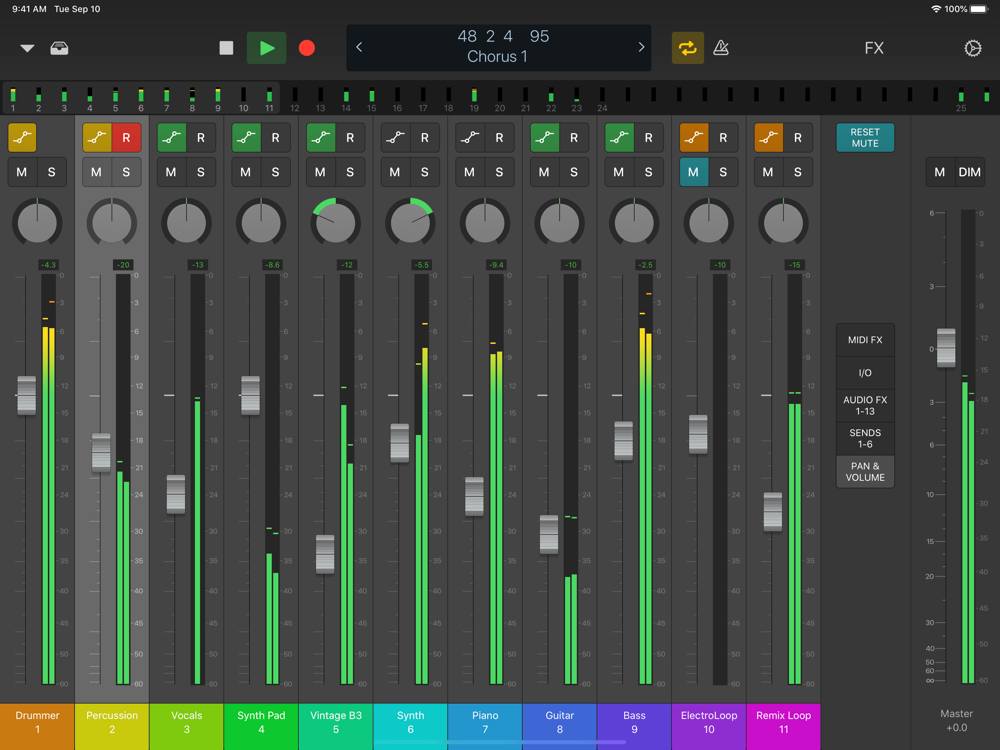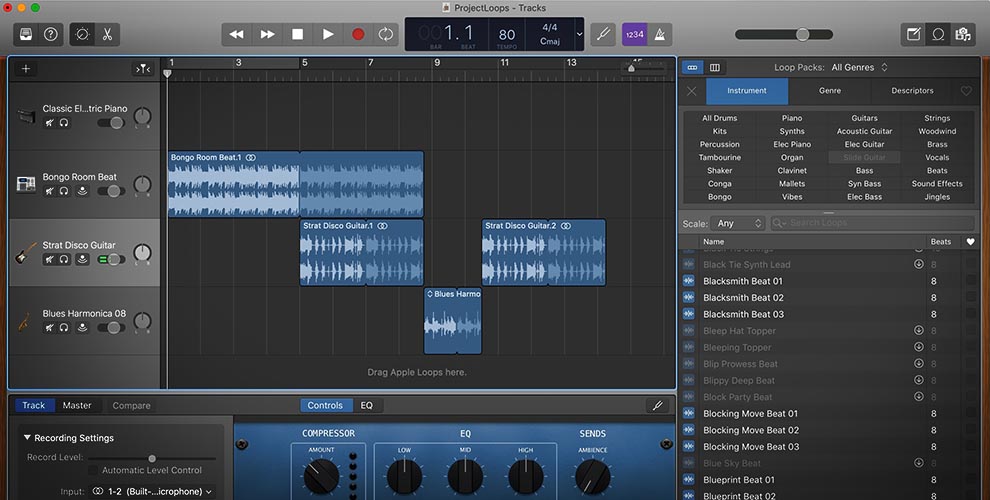GarageBand is the easiest way to create a great-sounding song on your Mac. Add realistic, impeccably produced and performed drum grooves to your song with Drummer. Easily shape the sound of any instrument in the Sound Library with Smart Controls. Crank up the bottom end with Bass Amp Designer, or mi. The keyboard in the GarageBand is set up like the standard keyboard and has a variety of keyboard instruments and some of which are customizable including grand pianos, electric piano, multiple organs, clavinet, synth tracks, and also the bass synth pads, and synths. It also has several different sounds.
GarageBand ‘09 comes with more than 100 software instruments, and each of those has dozens of presets that can sound like distinct instruments in their own right. That is a truly astounding number of sounds. In addition, Apple sells $99 Jam Packs, which offer even more instruments that seamlessly integrate with your existing ones.
Garageband Instruments free download - Apple GarageBand, Pro Pack For GarageBand, Texas Instruments OHCI Compliant IEEE 1394 Host Controller, and many more programs. Get more sounds and loops for GarageBand on Mac. After you install GarageBand on your computer, additional content—including patches, drummers, and Apple Loops—may be available. Some additional content may be needed to perform certain tasks. Adding More Instruments to Garageband Garageband makes it really easy to get in there and easily set up virtual instruments that come built-in. However, if you're going in to Garageband with the intention of using a third-party plug-in, you might be scrat.
But beyond GarageBand’s instruments, the universe of software instruments is vast, with prices that range from $500 or more for a single instrument to completely free for entire collections. This universe can be divided into roughly two galaxies: Sample-based instruments and synth-based instruments. To work in GarageBand, they simply need to support the Mac’s Audio Unit (AU) plug-in format.

I’ll introduce you to both varieties and walk you through the process of setting up and playing a collection of free sample-based instruments—Native Instruments’ Kontakt Factory Selection, and the free version of LinPlug’s synth-based instrument, Alpha 3.
Sample-based instruments
Software samplers are applications that store many small recordings of an instrument (or sound effect), and play them back in response to keyboard input. To enhance realism, creators of sample-based instruments painstakingly record each note of a real instrument at many different volumes, played in many different styles, and often with a variety of microphones.
To play a sample-based instrument, you need two components: The software instrument itself and a sampler or sample player. Samplers are sophisticated sample editors that are often pricey, while sample players are pared down versions of samplers that are often free.
Playing from Kontakt Factory Selection
First, quit GarageBand and download and install both the Kontakt 4 Player and the Kontakt Factory Selection instrument collection, both of which are available on Kontakt’s Website for free. Note that you can use the Kontakt 4 Player to play and record Factory Selection instruments (or your own recorded samples) for 15 minutes. However, you can use the Kontakt 4 Player indefinitely with other sample-based instruments that use the Kontakt format.
- Start a new GarageBand project and create a new software instrument track (Select New Track from the Track menu or hit Option-Command-N).
- Double-click the new track (the default is a Piano track, which will work for our purposes) or click on the track to highlight it and click the View Track Info button in the lower-right corner of the GarageBand interface.
- Hit the Edit Tab in the Track Info panel.
- Under Sound Generator, using the top menu (“Piano”), scroll down under Audio Unit Modules to select Kontakt 4. You’ll see the Piano image change to an Audio Unit icon (an orange sphere radiating to the right and left).
- Click on the icon to launch Kontakt.
- In Kontakt, navigate through the folders (in the Files tab on the left) to choose Factory Content.
- Navigate to a sound that interests you. Note: When Kontakt’s folders have plus signs, you can click on the plus sign or double-click the folder to open it. However, when there is no plus sign, you must double-click the folder name (not the folder) to see the individual instruments. The individual instruments will appear in the lower-left window, and will be identified by piano icons.
- Double-click an instrument to display its control panel in the right-hand window of the Kontakt interface (Be sure to drag the window left so you can see the whole thing).
- Play a few notes on your MIDI keyboard to hear the sound.

Tip: If you don’t have a MIDI keyboard installed, call up GarageBand’s onscreen keyboard by selecting Musical Typing from the Window menu (or hitting Shift-Command-K) and then play.
Synth(esizer)-based instruments

In contrast with sample-based instruments, synth-based instruments don’t play recordings; they produce (synthesize) their own sounds, after you tell them how to do so using dozens of parameters. In general, they tend to sound more otherworldly than sampler-based instruments. However, some synths use physical modeling techniques to emulate real instruments, and sound just as earthy and real as recordings.
To make things even more confusing, some sample-based instruments are called “synths,” not because they actually synthesize sound, but because they play back samples of synthesized sound.
Playing LinPlug’s Alpha 3
- Begin by quitting GarageBand and installing the free version of Alpha 3.
- Follow steps 2 through 5 above, substituting Alpha 3 for Kontakt.
- Just play (If you don’t have a MIDI keyboard installed, see tip above).
In my humble opinion, the free Alpha 3 default (as of this writing) has an interesting, spacious, and detailed sound.
Now you know what it takes to expand your instrument horizons; the universe is the limit!
[David Weiss is a San Francisco Bay Area based freelance writer.]
Let me begin by saying this tutorial is for people like me—amateur musicians composing for fun who aren’t ready to drop thousands of dollars on an expensive keyboard or patch set.
If you’re a professional musician, you’ve probably got tools that help you do most of this already anyway. This is just a really quick-and-easy beginner’s guide to get you composing with decent orchestral patches.
Free Garageband Vst Instruments
First, download the fantastic and free Sonatina Symphonic Orchestra. It’s a creative commons-licensed orchestral sample library with a wide range of instruments and variations. Check out the link to see the entire range of what’s included. It’s about 500Mb of samples stored in .sfz format. The .sfz file is just a simple wrapper which defines the parameters and points to the instruments which are in .wav format, so you can edit the parameter files in a text editor or the instruments in a sound editor. Very flexible.
However, you’ll probably just want to start using them. Once you’ve downloaded the instruments, you’ll need to download CamelSound’s free Alchemy plugin. Don’t worry when nothing shows up in your Applications folder after install—this isn’t a standalone app, it’s a plugin that you’ll be using from within GarageBand.

Free Garageband Instruments
After you’ve installed Alchemy, fire up GarageBand. Create a new project with a software track, then double-click the track to edit it. Select the edit tab. Just below “Sound Generator” there’s a dropdown. You should be able to select “Alchemy” under
“Audio Unit Modules”.
Free Au Instruments Garageband
You can now access the Alchemy controls by clicking on the thumbnail just to the left of the dropdown where you selected Alchemy. A new window should pop up with the controls.
Download Free Garageband Instruments
Now that you’ve got Alchemy running, feel free to play around with it. It’s a fantastic sound generation tool, especially good for the likes of dubstep, ambient or electronica. However, we’re here for orchestral. To load your orchestra samples, select “File” near the center top of the Alchemy popup. From this dialog box, you can select one of the Sonatina .sfz file you downloaded earlier. If you don’t have a keyboard hooked up, Select “Musical Typing” from the “Window” menu and start auditioning the samples.
Free Garageband Instruments
Happy composing! If you found this helpful, I’d love it if you shared a link to some of your compositions in the comments.